|
Our mountain trikes started out as ActionBent recumbents. ActionBents were designed for use on roads and paved trails. Jordan is riding the first one before modifications. Below is the same trike, set up for less civilized adventures. |
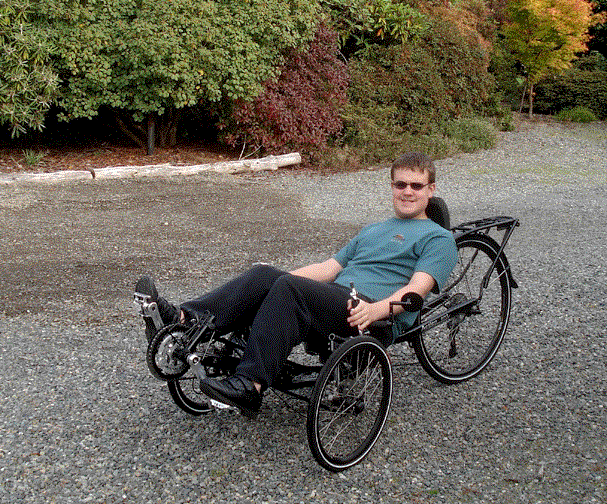 |
|
Our mountain trikes started out as ActionBent recumbents. ActionBents were designed for use on roads and paved trails. Jordan is riding the first one before modifications. Below is the same trike, set up for less civilized adventures. |
 |
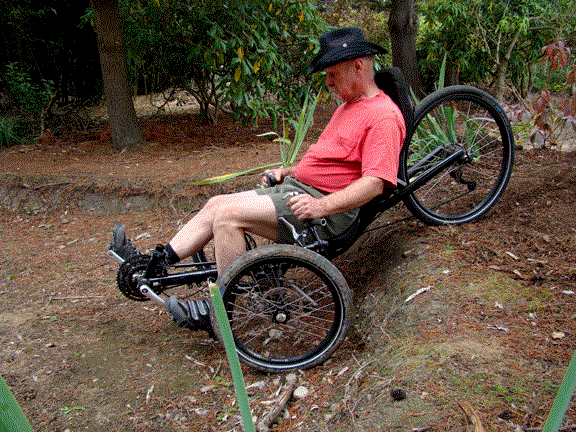
|
|
Left is mountain trike #2 the day I got it. Below is the day after. |
|
|
Mountain trike #3 began life as an ActionBent T-1. It is similar to the others except for the adjustable mesh seat. |
|
| Some changes will be necessary before this trike is ready for rougher trails. |
|
| At right, it is now prepared for the woods. |
The most obvious change in these trikes is what's missing. I removed all the non-essentials to reduce weight and protrusions. Mirrors, lights, racks, headrest, fenders--they all went. Racks are off most of the time so the both fit inside my Suburu Outback. For longer journeys, I attach them when I get to the trailhead. Interestingly, they are also useful for very steep climbs. Putting tools, water bottles, and other gear in a rear bag adds weight to the rear wheel and increases traction. When we don't use the racks, I carry a small bag of tools, spare parts, and a pump. Other essentials are a camera and water.
The other visible change is tires. I replaced the narrow, high pressure tires with soft, fat ones. The first trike has BMX tires on the front, the second Maxxis Hookworms, and the third Big Apples. The trikes usually have knobby mountain bike tires on the rear, although I change to a Big Apple 26 for less severe gravel trails.
The fat tires provide traction in snow, mud, and water.
Gearing was another major modification on these mountain trikes.
By changing the front triple to a quadruple with the addition of a Mountain Tamer and an 18 tooth chainring, I can get a very low granny--12 gear inches.
I can also get to 12 g.i. using a 24t small chainring in the front and a Dual Drive in the back. When I used the Mountain Tamer and Dual Drive in combination, the gear inches are further reduced to 9.
That gearing enabled me to climb Mt Peak (Pinnacle Peak) in Enumclaw, with 800 feet of elevation gain in less than a mile. All three trikes have been up.
This gearing enabled me to navigate some rough trail that replaced the washed out Carbon River Road in Mt Rainier National Park.
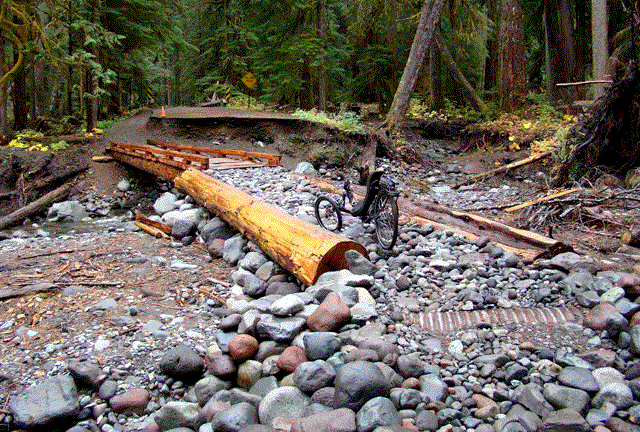
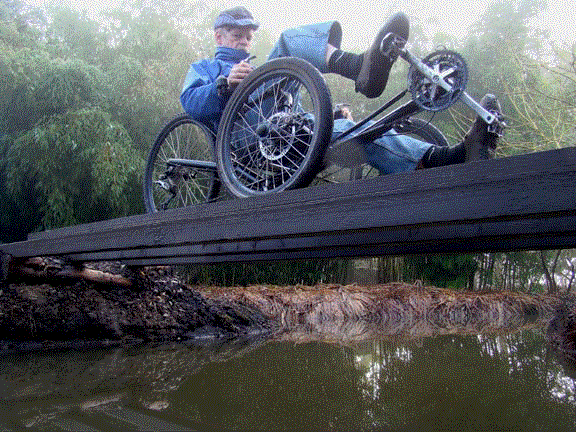
|
Not all mountain trike riding requires low gearing or superior traction. |
One of the reasons I chose the Actionbent for a mountain trike was that it is easily modified. It came with standard front triple chainring and rear cassette. It had a 26" rear wheel that accommodates a typical knobby mountain bike tire. With a few changes, the seat could be moved back a little and reclined more to increase weight on the rear wheel and increase traction.
Another reason the Actionbent made a good mountain trike was its light weight. My stripped down versions each weigh about 34 pounds. A few pounds makes a significant difference on a 20% grade.
Climbing isn't the only advantage of a light mountain trike. No matter how versatile your machine is, there will be times you may have to carry it. A narrow bridge. downed tree, and 100% grade (45°) have been some of the obstacles I have faced so far. 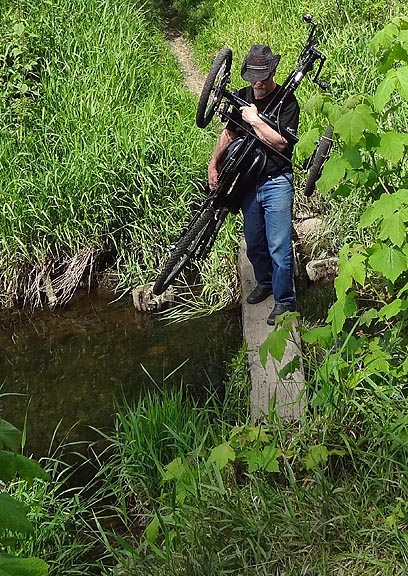
In Western Washington, unimproved trails often have sharp turns. A tight turning radius is essential. Trikes with direct steering, such as the ActionBent, can turn more sharply than those with indirect steering. (The handlebars control the front wheels directly, rather than through a linkage.)
But early models of the ActionBent (like Mountain Trikes #1 and #2) had a flaw--they had no Ackerman Compensation. When the front wheels of a tadpole trike (or any vehicle with two front wheels) turn, the inner wheel describes a smaller radius than the outer, so this difference must be compensated for. A set of lines connecting the wheel centers, the wheels, and the tie rod, make a parallelogram in an uncorrected setup, but a trapazoid with Ackerman Compensation.
The flaw turned out to be an advantage, at least when making mountain trikes out of these Actionbents. With correction plates, these trikes can make incredibly sharp turns.
Would you take a $4000 trike in a place like this? A final advantage of the ActionBent as a potential trail trike was the price. They are no longer in production (although clones are), and when they were, they had poor to nonexistant customer service, so they were scorned by much of the recumbent trike community. As a result, used ones are often quite inexpensive. All the moving parts are generic, so are readily available. If you don't spend an exhorbitant amount on your trike, you less hesitant to take it to the really fun places.